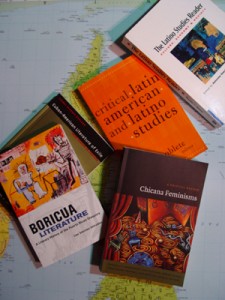Home
What is Latina/o Studies?

Latina/o Studies as a field is constituted out of the transdisciplinary study of Latina/o cultural production and experience in terms of a whole variety of factors. Latinas/os are defined as people of Latin American and/or Iberian heritage living and working in the United States or U.S.-based but also moving between the U.S. and the rest of the Americas. Latinas/os are ethno-racially diverse, of African, indigenous, Asian, and European descent; linguistically diverse, speaking varieties of English, Spanish, Portuguese, Spanglish, African, Asian, and indigenous languages; and culturally diverse, coming from more than 35 countries and 5 continents. Unlike Latin American Studies where the primary focus is on the cultures and experiences of various parts of Latin America (an umbrella term covering Mexico, Central America, the Caribbean, and South America), Latina/o Studies takes as its primary concern the presence of Latin America, Spain, Portugal, and the myriad combinations of Hispanic-Native-African-Asian-and-European non-Hispanic cultures within the borders of the United States.
However, Latina/o Studies is not confined within those borders either to the extent that its subjects of study (and the very creators of the field itself) are in motion and in flux, coming and going, continually crossing borders and boundaries. In this respect, it does share some of the transnational and transcultural scope, momentum, and issues of Latin American Studies but with its own foci, its own perspectives, that owe a great deal to Ethnic Studies and the knowledge produced in and through various intersecting civil rights movements. Latina/o Studies does not duplicate the work of Latin American Studies; it draws on it and complements it. Ideally, this scholarly relation works in reverse, too. Check out more information about the relation of Latin American and Latina/o Studies in the era of transnationalism and globalization in Critical Latin American and Latino Studies, edited by Juan Poblete.
A Sundry Field
Like Latin American Studies, Latina/o Studies is characterized by heterogeneity. Latina/o Studies encompasses Chicana/o Studies, Puerto Rican Studies, Cuban American Studies, Dominican Studies, Central American Studies, and so forth, and it must take into account the cultural production and the socio-economic and political experiences of a very diverse population located in many parts of the country, not just in the Southwest borderlands, though, of course, those are of primary importance given the historical and contemporary relation with Mexico (part of North America, after all, and from whence the United States took a quarter to a third of its territory). As such, Latina/o Studies offers plenty of opportunity for specialization.
Growth
At the same time, by virtue of being “Latina/o Studies” (a synthesizing rubric), it is characterized by research and invites courses that explore the mutual influence of and transculturation between different groups of Latinas/os in the United States and in the migrations across and within national borders. Thus, for instance, “Latinidad” or “pan-Latinidad” has become and will continue to be a debated and researched phenomenon. In 1980, Latina/os made up just 6.5% of the total U.S. population. According to the Pew Research Hispanic Center tabulations, Latina/os compose at least 18.3% of the total U.S. population. The importance and relevance of “Latina/o Studies” is not only demographic, but cultural and historical, not only about immigration but about the momentum and synergy of people who have long been within what is today known as “the United States of America.”
Interested in Learning More? Join Our Listserv!
When you join our listserv, you’ll get the latest information about our events, professional development opportunities, community events, news from our program, and more!
Leave a Reply




